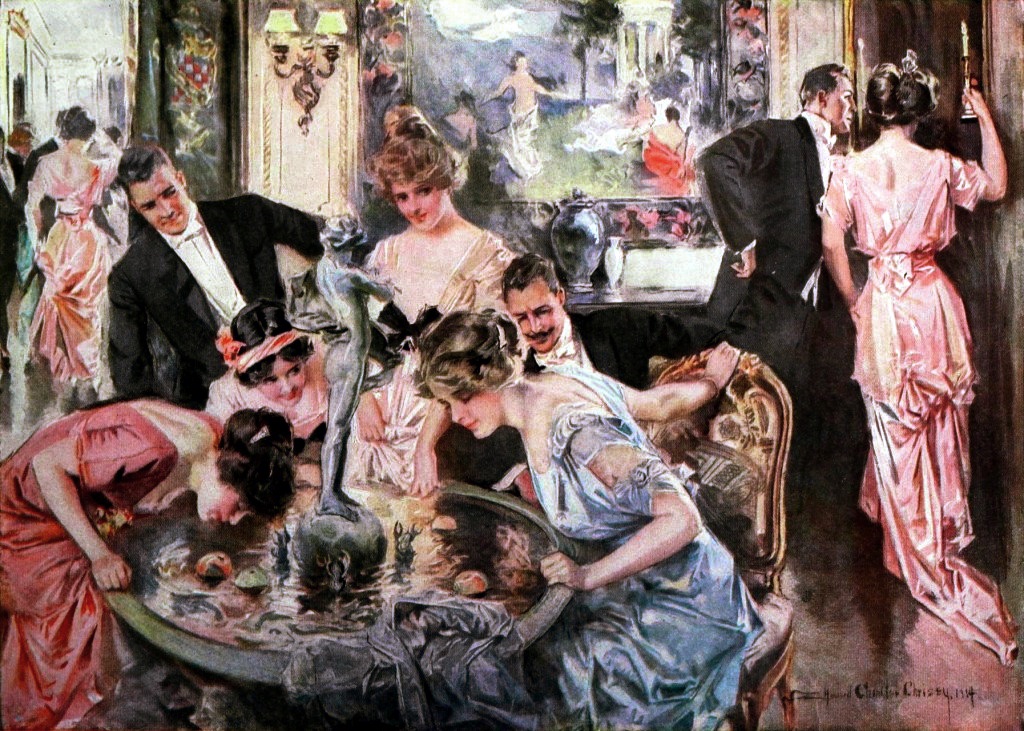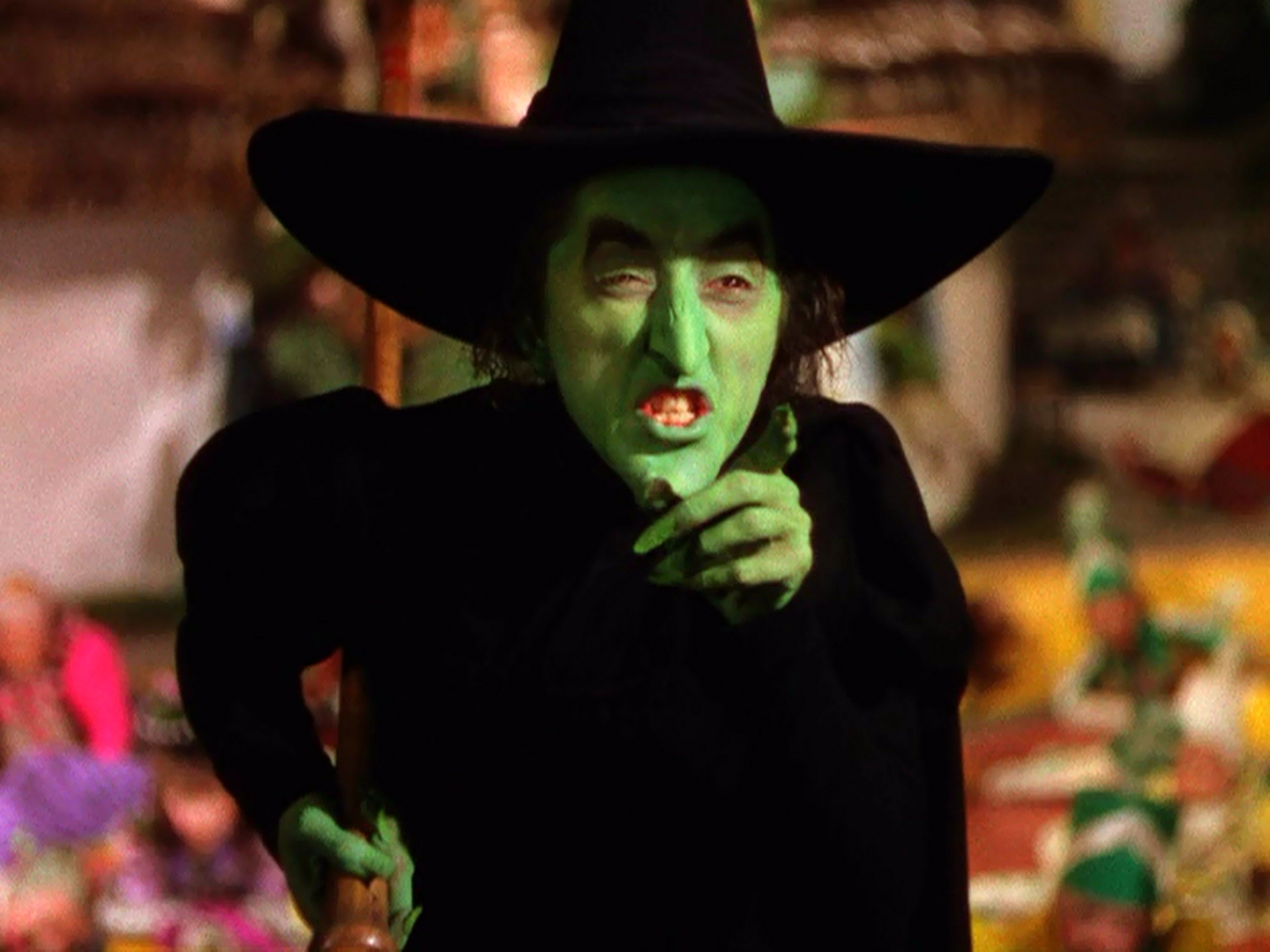
Fashionable ladies in 1915 “bobbing for apples…” (In England, 10/31 is also “Snap Apple night.”)
* * * *
 In case you’ve been living under a rock somewhere – or sticking your head in the sand to get away from all the negative political campaigning – Halloween is next Monday. (October 31.)
In case you’ve been living under a rock somewhere – or sticking your head in the sand to get away from all the negative political campaigning – Halloween is next Monday. (October 31.)
I’ve written of the religious meaning of this holiday before. And noted that the word “holiday” comes from the original “holy day.” (Or more precisely, “hālig dæg.”) In turn the Old English word “halig” figures into the whole idea of Halloween, but there’s more on that later.
I’ve written about Halloween in “All Hallows E’en” – 2015. And earlier – in 2014 – I posted On “All Hallows E’en,” Parts I and Part II. This post will present the highlights.
 One such highlight is that there are actually Three Days of Halloween. (Also known as the Halloween Triduum, which constitutes a whole set of Feast Days.) The third day of the three-day holiday – November 2 – is All Souls’ Day. The original idea was to remember the souls of “the dear departed,” illustrated by the painting at left.
One such highlight is that there are actually Three Days of Halloween. (Also known as the Halloween Triduum, which constitutes a whole set of Feast Days.) The third day of the three-day holiday – November 2 – is All Souls’ Day. The original idea was to remember the souls of “the dear departed,” illustrated by the painting at left.
Turning to the name itself, literally the night of October 31 is the evening – or e’en – before “Hallows Day.” (Or “All Hallows Day.”)
That is, “halig” is the old English word for “hallow,” which in turn is another term for “saint.” (In this sense, one of those dear departed.) So “All Hallows Day” is just another way of saying All Saints’ Day, which is celebrated on November 1, the day after October 31st.
And a side note: These three “holy-days” traditionally marked the “season of darkness.” In the olden days people started noticing that this time of year the days kept getting shorter. (So naturally they wondered if the days would eventually get so short there would be no light at all…)
So again, November 1st is also called All Saints’ Day, and the Old English word for “saint” was halig, which eventually became “hallow.” Another fact worth noting is that – in the really real olden days – Christians believed that on the Eve of All Hallows, “the veil between the material world and the afterlife thinned.” Put another way, the veil was most permeable.
(Spirits could more easily “pass through” the veil separating the dead from the living.)
So what was the deal with wearing masks and disguises?
As noted, people originally believed that on the night of October 31, the barrier between the living and the dead was pretty much down. So, those old-time people would wear masks or put on costumes in order to disguise their identities. The idea was to keep the afterlife “hallows” – ghosts or spirits – from recognizing the people in this, the “material world.”
 Another thing they did was build “bone fires:”
Another thing they did was build “bone fires:”
“The fires were thought to bring comfort to the souls in purgatory and people prayed for them as they held burning straw up high.” The idea came from pagan times, when evil spirits had to be driven away with noise and fire. (Note also that “bonfire” is short for bone-fire. See Bonfire – Wikipedia, noting the term “is derived from the fact that bonfires were originally fires in which bones were burned.”)
And there was another old-time custom. If you had to travel on All Hallows E’en – like from 11:00 p.m. until midnight – your candle could tell your future. If the candle you carried kept burning, that was a good omen. (The person holding the candle would be safe in the upcoming “season of darkness.”) But if your candle went out , “the omen was bad indeed.”
 The thought was that the candle had been blown out by witches.
The thought was that the candle had been blown out by witches.
There’s more information about “souling” and trick-or-treating in 2014’s On “All Hallows E’en” – Part I. There’s also a note about jack-o’-lanterns, like the one to the right of the paragraph, “In case you’ve been living under a rock…”
Apparently some old-time people set such carved-out pumpkins on their windowsills, to keep “harmful spirits” out of their home. But according to another tradition, jack-o’-lanterns “represented Christian souls in purgatory.” And as noted in “All Hallows E’en” – Part II, today jack-o’-lanterns are made from pumpkins, but were originally carved from large turnips.
In turn, both the jack-o’-lantern and Will-o’-the-wisp are tied in with the strange ghostly light known as ignis fatuus. (From the Medieval Latin for “foolish fire.”) That refers to the “atmospheric ghost light seen by travelers at night, especially over bogs, swamps or marshes. It resembles a flickering lamp and is said to recede if approached:”
Tradition had it that this ghostly light – seen by travelers at night and “especially over bogs, swamps or marshes – resembled a flickering lamp. The flickering lamp then receded if you approached it, and so it “drew travelers from their safe paths,” to their doom…
But there is some good news in all this, as noted in the readings for the “Eve of All Saints:”
[T]he souls of the righteous are in the hand of God, and no torment will ever touch them. In the eyes of the foolish they seemed to have died, and their departure was thought to be a disaster, and their going from us to be their destruction; but they are at peace.
That quote is from the Bible readings for the “Eve of All Saints (Day).” (Again, the earlier version was “Eve of All Hallows,” shortened to “All Hallows E’en,” then just “Halloween.”)
And that makes up the Good News of Halloween. So accordingly, here’s wishing you:
A Happy “All Hallow’s E’en!”
* * * *

“A graveyard outside a Lutheran church in Röke, Sweden on the feast of All Hallows…”
* * * *
The upper image is courtesy of Apple bobbing – Wikipedia, with the caption, “Halloween (Howard Chandler Christy), 1915.” The article added: “Due to the nature of the game, whereupon a number of individuals each place their entire head into a bowl of water, it is thought to be a somewhat unsanitary game… A potentially more sanitary variation of the game exists, with the apples hung on string on a line, rather than in a bowl of water,” like the Snap-Apple game shown above. (And that’s not to mention any possible Freudian implications…) And finally, “Agatha Christie‘s mystery novel Hallowe’en Party, is about a girl who is drowned in an apple-bobbing tub.”
Also re: Apple bobbing: “The current game dates back to when the Romans conquered Britain, bringing with them the apple tree, a representation of the goddess of fruit trees, Pomona. The combination of Pomona, a fertility goddess, and the Celts‘ belief that the pentagram was a fertility symbol began the origins of bobbing for apples. “
Re: All Saints Day (November 1). See also All Saints’ Day – Wikipedia.
The image of the jack-o’lantern is courtesy of Halloween – Wikipedia. The caption: “A jack-o’-lantern, one of the symbols of Halloween representing the souls of the dead.”
The painting to the left of the paragraph beginning “one such highlight” is courtesy of All Souls’ Day – Wikipedia, the free encyclopedia. The caption: “All Souls’ Day by William Bouguereau.” See also Allhallowtide, and All Saints’ Day – Wikipedia.
The “witch” image is courtesy of Hail to Dorothy! The Wicked Witch is dead …54disneyreviews.
The full Daily Office Bible readings for October 31, 2016 – from the Satucket website – are Psalm 34; Wisdom 3:1-9; and Revelation 21:1-4,22-22:5. The quoted portion is from the “Wisdom” reading.
The lower image is courtesy of Allhallowtide – Wikipedia, with the caption: “A graveyard outside a Lutheran church in Röke, Sweden on the feast of All Hallows. Flowers and lighted candles are placed by relatives on the graves of their deceased loved ones.”